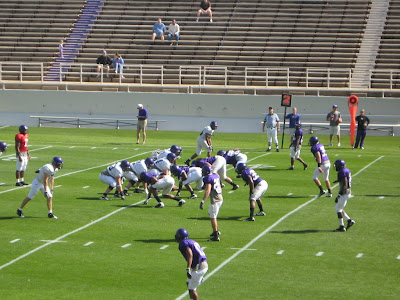 BYU has to replace 4 starters on its offensive line; it will promote 4 experienced linemen, and early indications are that the faithful blue need not fear much dropoff in performance from the new starters. Max Hall, now experienced both in highs and lows and itching to run more, pilots the Cougars' attack again. The defense, newly humbled, appears focused on recovering its conference-dominating form. BYU loses one fantastic skill player-- Austin Collie-- but returns an enviable roster at QB, TE, WR, and all-MWC pass rusher Jan Jorgensen.
BYU has to replace 4 starters on its offensive line; it will promote 4 experienced linemen, and early indications are that the faithful blue need not fear much dropoff in performance from the new starters. Max Hall, now experienced both in highs and lows and itching to run more, pilots the Cougars' attack again. The defense, newly humbled, appears focused on recovering its conference-dominating form. BYU loses one fantastic skill player-- Austin Collie-- but returns an enviable roster at QB, TE, WR, and all-MWC pass rusher Jan Jorgensen.The Cougars get one of the conference's most enviable home games: Florida State climbs to Provo in September, and likely will return to Tallahassee with a newfound respect for resurging BYU and the MWC. BYU also hosts CSU, Utah State, TCU, Air Force, and Utah this year, and may beat all of them. TCU and Utah, as usual, will be the Cougars' toughest competition. On the road, BYU opens at Oklahoma (the "neutral site" you'll see on schedules and commentary is a snicker-worthy figleaf), and also travels to Tulane, UNLV, SDSU, Wyoming, and New Mexico. Besides OU, which BYU won't beat, the Cougars must watch out for trap games at UNLV and New Mexico. However, BYU can realistically hope for 11-1, and might feel disappointed again if it wrings only 10 wins from this schedule.
 TCU learned to run the spread effectively in 2008, and appears poised to run the it most prolifically in '09. The Frogs' backfield, receiving corps, and offensive line are deep, experienced, and talented, giving Andy Dalton the weapons, room, and time to thrive in his third year at the helm. Look for the Frogs' O to dominate defenses all season.
TCU learned to run the spread effectively in 2008, and appears poised to run the it most prolifically in '09. The Frogs' backfield, receiving corps, and offensive line are deep, experienced, and talented, giving Andy Dalton the weapons, room, and time to thrive in his third year at the helm. Look for the Frogs' O to dominate defenses all season.The D will drop off only as much as Henry Nuitei and Jeremy Coleman don't develop at DT; look for the Frogs to hold the ball slightly less than last year's nation-leading figure (but score more), giving the D more time to show both its strengths and vulnerabilities. TCU travels to Virginia, Clemson, Air Force, BYU, SDSU, and Wyoming; taking sufficient intensity to win on the road has been a weakness for the Frogs. Unless corrected, look for TCU to drop 2 away from Fort Worth-- likely at BYU and Clemson. Coming to Fort Worth this year are Texas State, SMU, Colorado State, UNLV, Utah, and New Mexico. Likely only Utah stands a fighting chance to return home with a win.
The Frogs likely will win out at home, making for another 10-win season. If TCU ups its road focus, however, there's no juggernaut standing in the way of 12-0 in 2009; this season TCU goes as far towards undefeated as it wants to.
 Utah has more talent to replace the starters it lost from its eye-popping '08 season than it had after its eye-popping '04 season. Probably this means the Utes finish slightly behind BYU and TCU, but the proof of this pudding will be in the tasting, and if there's anything we learned about Utah last season, it's never to bet against them! So: lesson learned. Utah is clearly a contender in every game this season, but its road trips to Oregon, Fort Worth, and Provo are dangerous for the less experienced team, which the Utes will be each time. The Utes also travel to San Jose State, CSU, and UNLV. If health luck has run in the Rebels' favor, and not also in the Utes', Utah may lose in Las Vegas, as well.
Utah has more talent to replace the starters it lost from its eye-popping '08 season than it had after its eye-popping '04 season. Probably this means the Utes finish slightly behind BYU and TCU, but the proof of this pudding will be in the tasting, and if there's anything we learned about Utah last season, it's never to bet against them! So: lesson learned. Utah is clearly a contender in every game this season, but its road trips to Oregon, Fort Worth, and Provo are dangerous for the less experienced team, which the Utes will be each time. The Utes also travel to San Jose State, CSU, and UNLV. If health luck has run in the Rebels' favor, and not also in the Utes', Utah may lose in Las Vegas, as well.Utah State, Louisville, Air Force, Wyoming, New Mexico, and SDSU must play the Utes in Salt Lake City, and each of them will be the underdog (although watching Kragthorpe's power attack against Utah's new-ish defense will be a treat).
Look for Utah to reach 9 wins-- and do it three years faster than they did after their last BCS bowl. But any let-up from TCU or BYU, and the Utes may sneak into a tie for the conference championship.






















